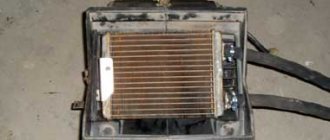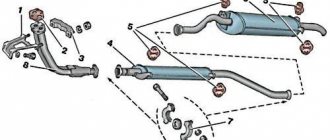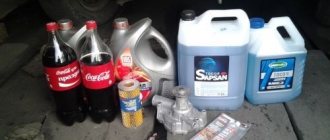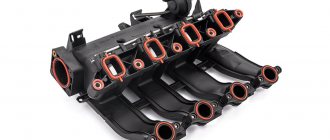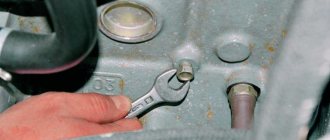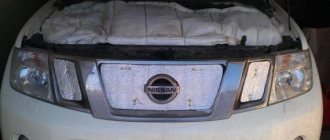When does the cooling radiator need to be flushed?
Clear signs that the cooling system needs cleaning:
- the cooling fan turns on more often, and not only at idle, but also while driving;
- the engine heats up quickly;
- Antifreeze is thrown out of the expansion tank when heated;
- the bottom of the radiator and the lower pipe are cold, the upper hoses of the cooling system are hot;
- the heater in the car does not heat well;
Over time, scale accumulates in the cooling system. When draining the coolant from the radiator, pay attention to the content of sediments, particles and color changes in it.
A cloudy liquid containing particles of an unknown substance indicates that there is probably scale on the walls of the system. Although not always, even clean liquid indicates the good condition of the radiator from the inside.
A sealant can also get into the coolant, which can be used to seal small cracks and holes. Oil may also get in here.
Types of cooling system cleaning
Cleaning the car cooling system is divided into internal and external work.
Interior work . Internal cleaning involves eliminating traces of corrosion, engine oil residues, coolant (antifreeze or antifreeze), as well as accumulated scale.
Exterior works . Consists of external cleaning of all components of the cooling system. That is, we wash off dust, dirt, sand, etc. from it. It is also necessary to thoroughly wash off any insects adhering to it from the radiator honeycomb.
Which exit?
The problem is that washing a radiator is a complex technological process. Few people know that a car has not one, but several radiators. In addition to the large front one, there is an auxiliary one, there is also an oil cooler and an automatic transmission cooler. They are oriented towards the incoming air flows and are mounted deep in the engine compartment. It is hidden radiators that are often in the most contaminated state and cause overheating of the engine and transmission. It is impossible to get to them without disassembling some of the removable parts of the front end. Usually this is a bumper, grille and other fastening devices.
Next comes the most difficult thing: to wash the radiators so that the car does not become completely immobilized. Some would-be car washers simply take a Karcher and launch a jet under a pressure of 150 bar into the engine compartment. Often such things are done at ordinary car washes by randomly hired employees. For a modern car, this barbaric procedure is like death. Electronics fail, and sensors and sensors begin to malfunction. The on-board system generates errors. And these are the most harmless of misfortunes. It is much worse if the jet hits the black box near the radiator that hides the engine control unit. Then it’s a lost cause, repairs will cost several tens of thousands of rubles.
The solution is simple!
You cannot save on things that directly affect the performance of your car. When cleaning radiators, you must contact a professional service center that provides a guarantee for the work performed, and not for a regular wash.
Cleaning engine cooling radiators at the Studberg technical center costs only 10,080 rubles. Including refilling the air conditioner.
How and with what to flush the inside of the radiator?
To flush the radiator from the inside, you can use one of the following products:
- Citric acid;
- Pepsi or Cola;
- Electrolyte;
- Distilled water;
- Finished drugs;
Let's talk about each of these methods in more detail.
Flushing the cooling radiator with citric acid
1). As in general and with almost any manipulations with the cooling system, you need to wait until the power unit cools down completely, otherwise you can get unpleasant and, in some cases, dangerous burns from steam escaping through the radiator cap.
2). We prepare the solution as follows: dilute 100 grams of citric acid with the volume of water that is enough to fill the engine cooling system.
3). Next, we need to drain the used liquid and fill in the prepared composition instead. We've been driving the car for about a week. During this time, when interacting with acid, all contaminants inside the cooling system and heat exchanger are dissolved.
4). After a week, the liquid with acid must be drained, and the entire system must be rinsed from the inside with distilled water, after which we fill the cooling system with antifreeze or antifreeze.
Flushing the cooling radiator with cola (or pepsi)
1). We drain all the liquid from the cooling system and pour in Coca-Cola, previously heated, so that carbon dioxide does not escape from it.
2). If the nature of the deposits is not critical, it will be sufficient if the engine runs for 5-10 minutes. But in cases where pollution greatly burdens the system, then it is necessary to ride during the day.
3). Then drain the Cola, rinse it with distilled water, and then fill it with fresh coolant.
Flushing the cooling radiator with electrolyte
To flush the radiator, you can also use battery electrolyte with a density of 1.27.
1). In a large 10-liter bucket, mix clean water with a liter of this substance, then pour the resulting solution into the cooling system.
2). All trips on this day must be made with a filled radiator, which will allow it to be cleaned as much as possible.
3). In the evening, drain the solution and rinse the radiator with clean water, then add coolant.
Attention! I have not personally used this method, but according to reviews on the Internet, electrolyte is also an effective means for cleaning a radiator.
Flushing the radiator with distilled water
If, when replacing the coolant, you do not notice any special contamination, then it is quite possible to get by with distilled water. It is not recommended to use tap water with a large amount of salts and impurities. As an example, you can take a kettle, on which scale appears after using tap water.
1). Pour clean water into the radiator and start the car at idle speed.
2). 20 minutes after operating in this mode, drain the water and add coolant.
Ready-made drugs
Today you can find many options for special flushing fluids on sale. They can be either alkaline or acidic. They are best used according to the instructions.
Video
New service - radiator cleaning without dismantling
We have developed and implemented a new service - radiator washing without dismantling. A special installation allows you to remove accumulated dirt from the radiator without deforming the lamellas.
Brief description of the service
The LR.RU service offers a radiator flushing service using a special system. The installation, which supplies water and air into different channels, allows you to flush the radiator without dismantling it and does not require draining the antifreeze. There is also no need to refill the air conditioner with freon, since it does not require dismantling.
Washing the radiator without dismantling takes much less time than washing according to the standard procedure, which involves draining the antifreeze, dismantling and washing the radiator using a high-pressure washer (Kärcher). In this case, there is a risk of deformation of the radiator from the pressure of the water jet. The installation we use to flush the radiator completely eliminates the risk of the radiator lamellas being crushed.
The cost of the service is 2250 rubles. Pre-registration required.
How is the procedure done?
The entire procedure for washing the radiator without dismantling in the LR.RU service consists of 3-4 passes and generally takes about an hour (in severe cases – an hour and a half), plus preparing the car requires another ten to fifteen minutes.
In the installation that the LR.RU service uses for washing radiators, the main component is air. Using water and a detergent cocktail, he blows pre-soaked dirt out of the radiators under pressure. Thanks to this, the radiator lamellas are not damaged, because the water supply pressure in this installation is significantly lower than in devices used by other car services.
What is it for?
Do you know why washing the radiator is an important item in the list of car maintenance activities and is not inferior in importance to such work as changing oil and filters?
The radiator is one of the important elements of the car's cooling system. Its efficient operation is ensured by a special design consisting of narrow honeycombs. The counter-flow of air passing through them cools the liquid contained in the system and thereby protects the engine from overheating. However, along with the air, a large amount of dirt, dust and other solid particles enters the radiator. They accumulate in the narrow cracks of the radiator and thereby affect the operation of the entire cooling system.
After a year and a half of active use of the car, due to dirt accumulated in its honeycombs, the radiator can no longer cope with natural cooling while driving. This leads to the fact that the temperature of the antifreeze begins to rise and after it overcomes a certain threshold, which is significantly higher than the operating temperature, a fan comes to the aid of the engine. Its regular activation means that the engine almost constantly operates in violation of the temperature regime. Sooner or later this will affect the condition of the car. Firstly, drivers and passengers will have to forget about a comfortable stay in the car (which is critically important on hot summer days in hours-long traffic jams). And, secondly, the working components of the car will inevitably begin to fail, and they will require expensive repairs.
To prevent such problems, regular radiator flushing is necessary. In most car services, this is carried out according to a standard procedure. First of all, the antifreeze is drained. The so-called “blanket” of poplar fluff and dust is removed. Afterwards, the radiators are dismantled and washed using Karcher. Unfortunately, despite the apparent effectiveness of this technique, it rather has a negative effect on the operation of the radiator. Improvement, if it happens, will be short-term. This is explained by the fact that the radiator honeycombs are very easily damaged by powerful jets of water. And a radiator with damaged, bent lamellas copes just as poorly with the task of cooling the engine as a radiator whose honeycombs are clogged with dirt. In both cases, the radiator cannot pass air properly and the engine does not cool properly. In addition, do not forget that damaged honeycombs become clogged with dirt several times faster, and for this reason washing will soon be needed again.
What is unique about LR.RU technology?
LR.RU offers a radiator cleaning service using a unique system. It provides for flushing the radiator without dismantling, and also guarantees the safety of the cells. A special installation used by service staff allows you to remove accumulated dirt from the radiator without deforming the lamellas. A special apparatus supplies water under low pressure, and air is supplied through a separate channel at higher pressure. This combination allows you to wash the radiator efficiently and without damage. A significant advantage is that for the radiator flushing procedure there is no need to drain and refill antifreeze. There is also no need to refill the air conditioner with freon, since it does not require dismantling.
To summarize, let us once again talk about the significant advantages of contacting LR.RU for radiator flushing:
Washing the radiator without dismantling takes less time than washing according to the standard procedure, which involves draining the antifreeze, dismantling and washing with a Karcher.
The installation that Lr.ru employees use to flush the radiator does not crush the lamellas.
If you still have questions, you can find out additional information about flushing the radiator without dismantling from the employees of the Lr.ru center by phone: + 7 (495) 649 60 60 or car service, direct phone number of the master consultant
Service hours are from 10:00 to 20:00 (except Sundays).


